PinotFile: 11.12 October 27, 2017
|
Understanding Pinot Noir Clonal DiversityAn excellent article appeared in 2017 in the erudite UK wine journal, The World of Fine Wine. The article’s relevance to Pinot Noir caught my interest, and since a majority of PinotFile readers undoubtedly do not read this journal, I wanted to share the pertinent information contained therein with you. Written by Anne Krebiehl MW, the article was titled, “Pinot Noir: Cracking the Clonal Code.” Anne is a freelance wine writer and lecturer who contributes to a wide variety of trade and consumer publications in the UK, USA and Germany. Her varied interests include German, Austrian, Italian and New Zealand wines, but her particular focus is on Pinot Noir, Riesling and traditional-method sparkling wines. She was admitted to the Institute of Masters of Wine in September 2014. Some of the information here is from my own research. The author begins by debunking the often-stated dictum that Pinot Noir is more prone to mutation and less genetically stable than other Vitis vinifera varieties. John Haeger, in his landmark reference book on Pinot Noir, North American Pinot Noir, states, “Pinot, by virtue of its genetic instability and its predisposition to spontaneous mutation….displays a very broad range of phenotypes. Several hundred clones of Pinot Noir are thought to exist.” Haeger’s statement does not implicitly say that Pinot Noir has superior proclivity for mutation compared to other wine grapes. In the encyclopedic reference, Wine Grapes, Jancis Robinson and et al, assert, “Pinot has hundreds of clones simply because it is very old, not because it is naturally more prone to mutation than other varieties.”
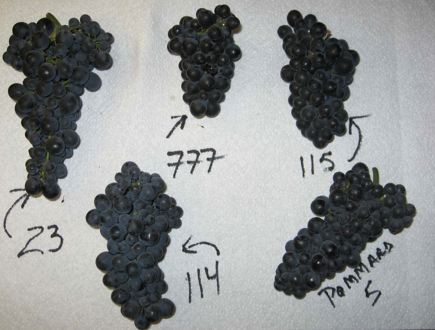 Krebiehl’s research indicates that the first official clonal selection of Pinot Noir clones in Burgundy began in 1960, when INRA sourced the first clonal selections of Pinot Noir from vines planted at Domaine Ponsot in Morey-St-Denis. This led to the first certification of Pinot Noir clones numbered 111-115 in 1971. Clonal selection research began much earlier in Germany, the home to the first official research on Pinot Noir clonal selection, dating to the late 1920s. Official Swiss research on clonal selection of Pinot Noir began in the 1950s, and in 1952 three clones from Wädenswil were imported to UC Davis (UCD 1A, 2A, 3A). The Mariafeld clone (UCD 13,15) also came from Switzerland. Much of the history and source of mother clones from Europe brought to California is shrouded in mystery. It is thought that European cuttings of Pinot Noir were brought into California in the 1850s and 1860s, including vine cuttings from Burgundy by Agoston Haraszthy. The Mt Eden clone was brought to California from Burgundy by Paul Masson in the 1890s, supposedly sourced from Corton and Corton Charlemagne. Martin Ray, who later owned Paul Masson’s vineyard, supplied grape scion to Chalone, as well as Dr. Stanley Hoffman at HMR Vineyard in Paso Robles and Dr. David Bruce in the Santa Cruz Mountains (see note below on the David Bruce clone). Merry Edwards sent cuttings of a single Mt Eden vine to UC Davis where it was certified as UCD 37. The Jackson clones (UCD 9, 16) originated from experimental plantings in the town of Jackson in the Sierra Nevada region of California. The Wente “clone” is probably many selections from early plantings in the Arroyo Sect region of Monterey County. The Swan clone (UCD 97) is a Pommard selection probably sourced from Burgundy and planted by Joseph Swan in the early 1970s. But to make the story more confusing, at least one of the so-called Swan clones (selections) came from Mount Eden. The widely domestic plantings of the Pommard clone take their origins from Dr. Harold Olmo of UC Davis, who imported two Pinot Noir clones in the 1940s, one each from France and Spain. Neither clone apparently has documented provenance according to Krebiehl, but I have read that the French import was sourced from Chateau de Pommard. This import became UCD 4 and the heat-treated forms UCD 5 and UCD 6. UCD 5 was introduced to Oregon by Dick Earth and Charles Court as part of their joint nursery venture in the early 1970s. Olmo also developed the Martini clone (UCD 13,15) along with Louis Martini from vine cuttings taken from Inglenook and subsequently planted at the Stanly Ranch in Carneros. Roederer clones (UCD 32,33,41) were introduced in 1984 after importation form Champagne.
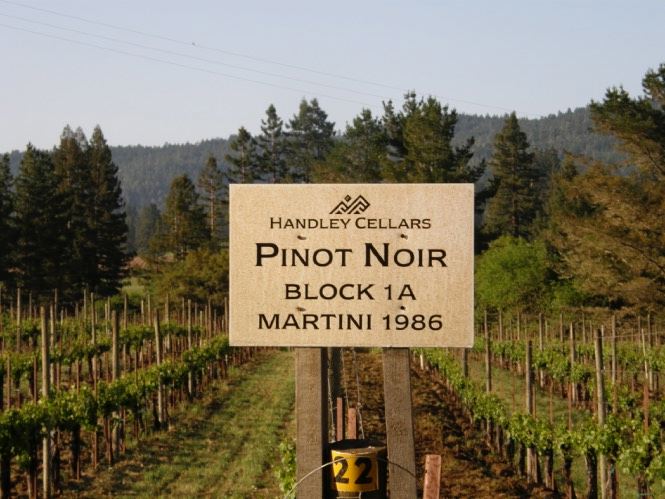 The so-called Calera clone is actually a number of selections reportedly brought from Burgundy’s Domaine de la Romanée-Conti (DRC) or sourced from Chalone by Josh Jensen who founded Calera Wine Company. Select, Reed and two-thirds of Jensen were planted with suitcase clones either from DRC or Chalone or both. Jensen has never disclosed the origins of his early plants, but he spent time working at both DRC and Domaine Dujac before he founded Calera Wine Company. Today, Calera selections are widely planted in Domaine Dujac before he founded Calera Wine Company. Today, Calera selections are widely planted in California. There is no David Bruce clone per say, as it represents any number of Pinot Noir selections of undetermined clonal origins. Bruce obtained his original cuttings from Wente’s Arroyo Seco vineyard and Martin Ray’s vineyard at what is now known as Mount Eden. The origins of the so-called Coury clone of Pinot Noir remains enigmatic. Coury studied viticulture and clonal adaptation at INRA in Colmar, Alsace, France in 1964 and it is thought by David Adelsheim and others that Coury smuggled cuttings from Colmar into the United States upon his return. It is possible that he brought in clone 538, the only clone of Pinot Noir available at Colmar at the time. Coury never disclosed the clonal or selection type but the “Coury clone” is common parlance among winegrowers, referring to plantings Court sold from his nursery in the 1970s to growers and wineries in Oregon and mistakenly considered a Pommard clone. Dick Earth had a friend who gave him smuggled cuttings that lay on the ground at Clos Vougeot in Burgundy in 1975-1976. The cuttings were sent to UC Davis where the material tested positive for virus. After undergoing microshoot tip tissue culture virus elimination, the selection was designated as FPS 95. In 2005, it tested positive for leaf roll virus, and was later advanced to FPS 117. The workhorse clones in the 1970s in California and Oregon were the three heritage clones available from UC Davis: Pommard, Wädenswil and a minor clone mislabeled as Gamay Beaujolais. The eventual importation of the Dijon clones of Pinot Noir from Burgundy into Oregon was to dramatically change the course of Pinot Noir wine growing in the United States. The full story: www.princeofpinot.com/article/945/, “Romancing the Dijon Clones.” According to Krebiehl, the ENTAV-INRA’s database currently lists 47 permitted clones of Pinot Noir, including sparkling wine varieties. However, other collections in Burgundy and Champagne add up to at least 800 clones. Of the Dijon clones commonly planted, 113, 114 and 115 date to 1971, clone 667 to 1980 and clone 777 (along with 115, the most popular Pinot Noir clone in the world) in 1981. “828” followed in 1985 and 943 in 1989. The true Dijon clone 828, available from the UC Davis FPS Foundation Vineyard, a cleaned-up version (lacking the Red Globe virus) of the original ENTAV-INRA clone, became available in 2012. Older plantings are referred to as faux “828”, upright “828,” or ASW2. Two ENTAV-INRA clones released in 2013, 1196 and 1197, are described by Krebiehl as “producing structured wines with complex and distinctive Pinot Noir aromas, olfactory intensity, and tannin suppleness.” An important point of understanding about clones, and one that has been reiterated numerous times by viticulturists and winemakers, is that site trumps clone. In other words, as Dr. Gerald Atkinson notes in Krebiehl’s article, “It is accepted now in genetics that there are epigenetic responses. One and the same clone in different vineyards will respond differently.” Krebiehl emphasizes that Pinot is very prone to producing different phenotypes of the same genotype or clone as it is very environment-sensitive. Pinot Noir’s response to its environment can lead to a variation in the way it expresses its genes. Krebiehl concludes, “Now that three Pinot-clone research institutes in France, Germany and Switzerland are each offering an array of clones for numerous conditions and purposes, as well as conservatory collections, and with further collections and trials held wherever Pinot Noir is grown, the diversity in this single variety is mind-boggling and well worth exploring….While clones alone do not hold the secret to a great wine and constitute only one element among thousands in wine’s almost infinite matrix of variables, they are a fascinating link to the past and a continually adapting key to the future.”
The World of Fine Wine is a beautifully illustrated 200+ page magazine published quarterly for wine enthusiasts and collectors and available in both print and digital formats. For subscriptions, visit www.worldoffinewine.com.
Sips of Recently Tasted Pinot Noir & Chardonnay
Black Kite Cellars, Santa Rosa, CABlack Kite Cellars focuses on producing small lots of Pinot Noir from the varied blocks at the estate Kite’s Rest Vineyard in Anderson Valley, as well as Pinot Noir and Chardonnay from other expressive vineyard sites in the Santa Lucia Highlands and the Sonoma Coast. Visit www.blackkitecellars.com.
2015 Black Kite Gap’s Crown Vineyard Sonoma Coast Chardonnay 14.6% alc., pH 3.40, TA 0.65, 116 cases, $58. Dijon 76, 95 and 96. Aged 18 months in French oak barrels, 50% new. · Light golden yellow color in the glass. Aromas of lemon creme, white flower blossom, spice and brown sugar increase in intensity over time in the glass. Flavors have a unique profile, including lemon, spiced apple, pineapple and various warm spices as well as a floral tone. Nicely balanced, with a clinging, citrus-driven finish. Score: 90
2015 Black Kite Soberanes Vineyard Santa Lucia Highlands Chardonnay 14.1% alc., pH 3.30, TA 0.70, 135 cases, $48. Went clone. Aged 11 months in French oak barrels, 40% new. · Light golden yellow color in the glass. Subdued aromas of lemon zest, wet earth, toast, and coffee. An acid-driven style, with bright flavors of citrus and green apple. Slightly creamy in texture, with a burst of oak in the background. When tasted the following day, the oak had integrated better but the wine still had a buttery popcorn and toffee tone framing the lemon core. Score: 89
2015 Black Kite Sierra Mar Vineyard Santa Lucia Highlands Chardonnay 14.1% alc., pH 3.26, TA 0.66, 188 cases, $48. Aged 11 months in French oak barrels, 40% new. · Moderate golden yellow color in the glass. Nicely perfumed with aromas of yellow apple, yellow grapefruit and buttery brioche. Rich and creamy on the palate in a fuller-bodied style offering flavors of lemon, yellow grapefruit, , grilled pineapple, yellow peach, and nectarine with a subtle note of toasty oak. I like this wine not so much for its rich and seductive flavor, but for its balance. Well-crafted in this style. Score: 92
Briceland Vineyards, Redway, Humboldt County, CAA boutique winery producing small amounts of Pinot Noir and other varietals from vineyards in Humboldt, Mendocino and Lake counties in Northern California. The winery was originally founded in 1985 by winemaker Joe Collins and his partner Maggie Carey. Today, Andrew Morris has assumed ownership and winemaking duties. The winery has been a long time contributor of wines for review to the PinotFile.Visit www.bricelandvineyards.com.
2014 Briceland Ronda’s Vineyard Humboldt County Pinot Noir 13.4% alc., 97 cases, $35. Vineyard is situated at 1600 feet elevation a few miles from Briceland. Organically grown grapes. · Moderately light garnet color in the glass. Aromas of interest include earthy flora, dark cherry pie filling, warm spices and a hint of oak. Light to mid weight in style, with a crisp, bright core of red cherry fruit accent by savory dried herbs and a hint of toast and vanilla. Modest tannins with good Pinot character, finishing with a slightly tart, cranberry note. Score: 89
2014 Briceland Phelps Vineyard Humboldt County Pinot Noir 13.6% alc., 71 cases, $35. Organically grown grapes. Aged more than one year in French oak barrels. Bottled unfixed and unfiltered. · Moderately light garnet color in the glass. Aromas of cherry, sweet oak and terra-cotta lead to a mid weight wine featuring flavors of black cherry, dark berry, spice and disagreeable oily note. Welcome generous fruit on the finish, but also significant fine-grain tannins that stick out. Score: 88
2014 Briceland Alderpoint Vineyard Humboldt County Pinot Noir 12.7% alc, 98 cases, $35. Vineyard planted in 1991 and tended by Rey Sanchez. · Moderately light garnet color in the glass. There is noticeable oak overlay in this wine offering aromas of chocolate cherry, pipe smoke and underbrush, and flavors of strawberry, cherry, raspberry and a woody, ash thread. The wine has smooth tannins, bright acidity and a pleasing finish with some length. When tasted the following day from a previously opened and re-corked bottle, the oak was still pushing for dominance over the fruit. Score: 88
Brick House Wine Company, Newberg, ORFounded in 1990 by former CBS foreign correspondent Doug Tunnell, this is one of the few Oregon wineries I have never really connected with or visited. Tunnell was a pioneer in certified organic and biodynamic grape farming in Oregon. His 40-acre Brick House Estate Vineyard is planted to both Pinot Noir and Chardonnay in the Ribbon Ridge AVA. A small amount of Gamay Noir is also planted and produced. Tunnell crafts 3500 cases annually in a converted barn winery and are consistently highly lauded by the wine press. The winery is open by appointment and on Memorial Day and Thanksgiving weekends. Visit www.brickhousewines.com.
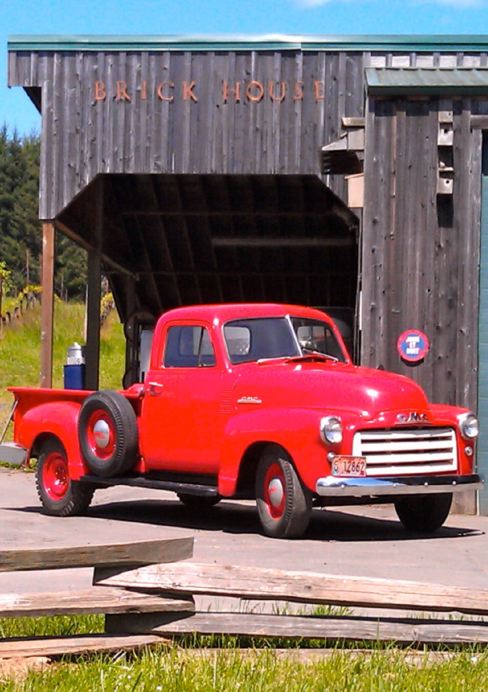
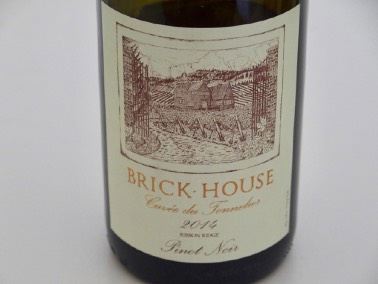 2014 Brick House Cuvée de Tonnelier Ribbon Ridge Oregon Pinot Noir 14.1% alc., $48. The name of the wine roughly translates to “barrel maker’s cuvée.” The wine is blended from the oldest vines on the farm, a 10-acre block of Pommard clone just south of the brick house planted in 1990. Natural yeast fermented. · Moderate garnet color in the glass. Clean and fresh aromas of black raspberry and blackberry build in the glass over time. Light to mid weight in character in a beautifully elegant and masterfully crafted wine offering flavors of black cherry and black raspberry. Everything is in sync with an impressive attack and glorious finish. Submerged tannins make for easy approachability. Score: 94
2014 Brick House Les Dijonnais Ribbon Ridge Oregon Pinot Noir 14.1% alc., $52. Sourced from Dijon clones planted on the farm in 1995. This bottling represents the best barrels from this site. Natural yeast fermented. · Moderate garnet color in the glass. Aromas of dark berry melange and peppery spices yield increasing charm over time in the glass. Silky and refined on the palate, with a mid weight core of dark grape, blackberry, boysenberry and pomegranate flavors underpinned with welcome notes spice, savory herbs and earth. Vivid in the mouth due to juicy acidity, modest tannins and a complimentary oak sheen in the earth. Score: 93
2014 Brick House Evelyn’s Ribbon Ridge Oregon Pinot Noir 14.1% alc., $68. A barrel selection of equal parts Dijon and Pommard clones. This bottling is the finest wine the estate vineyard has to offer. Named in honor of the winemaker’s mother. Raised on gross lees in barrel for a minimum of 16 months. A larger percentage of new French oak and whole cluster fermentation give this wine its long term age ability. · Moderately dark garnet color in the glass. Clearly a special wine on encountering the seductive aromas of fertile earth, black strawberry, raspberry and oak spice. The best nose in the lineup. The charge of mid weight plus blue and black fruits is mouth filling and the result is an impression of boldness and ripeness. A sturdy backbone of tannins matches up well with the sappy fruit, a slip of oak adds character, some earthiness chimes in, and the finish lingers indefinitely. the wine can be enjoyed now, but has the balance and structure to age magnificently. Score: 95
Burn Cottage Vineyard, Central Otago, NZThis 68-acre estate near Cromwell and close to Felton Road has 27.5 acres planted to primarily Pinot Noir vines. Ted Lemon, owner and winemaker at Littorai, has been a partner with the Sauvage family, Americans hailing from Kansas. The property’s vines began setting fruit in 2006 and the first commercial wine followed in 2009. I have reviewed Burn Cottage Pinot Noir from four vintages from 2009-2013. Claire Mulholland, former head winemaker at Martinborough Vineyards and Amisfield is the associate winemaker. The interesting images on the label are from Johann Wolfgang von Goethe’s biodynamic allegory, “The Green Snake & the Beautiful Lily,” appropriate since the Burn Cottage Vineyard is biodynamically farmed in keep with Lemon’s firm commitment to this form of viticulture. Imported by Classic Wines LLC, Denver, CO. Available at K&L Wines. Visit www.burncottage.com.
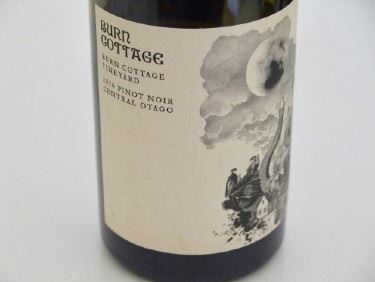 2014 Burn Cottage Central Otago New Zealand Pinot Noir 13.4% alc., $55. · Dark garnet color in the glass. Aromas of blackberry, pomegranate juice, muddy earth and a hint of whole cluster lead off. Bold flavors of blackest cherry, blackberry and Hoison sauce flood the mouth with goodness. Ostentatious fruit expression yet not jammy, with balancing acidity and immersed tannins. Some oak-driven tobacco and toast notes ply the background. The wine offers advanced fruit maturity at a modest ABV. I sense the whole cluster inclusion in this wine by the texture and structure. The grand finish is a fitting climax. Score: 93
Cutruzzola Vineyards, San Luis Obispo, CAPinot Noir from a 5-acre vineyard seven miles east of the town of Cambria on California’s Central Coast. Located on predominantly south-facing broken hills, the vineyard is now between 9 and 14-years-old allowing the vines to flourish with minimal irrigation. The winemaker is Stephen Dooley of Stephen Ross Wine Cellars. A tasting room is located on Main Street in the town of Cambria where Riesling and Chardonnay are also offered. Pronounced “Koo-troot-ZOL-a.” Visit www.cutruzollavineyards.com.
2014 Cutruzzola Riven Rock Vineyard San Luis Obispo County Pinot Noir 14.4% alc., pH 3.50, TA 0.548, 123 cases, $48. Released September 2017. This bottling includes all clones planted in vineyard (Pommard 5, 667, “828,” 115 and 23). 2-day cold soak, 10-day fermentation on skins with 20% whole cluster using Assmannhausen and RC212 yeasts. Aged 11 months in French oak barrels, 0% new. · Moderate garnet color in the glass. Shy, but pleasant aromas of dark red fruits, damp flora and pasture. Satisfying mid weight flavors of boysenberry, blackberry and candied plum framed by modest tannins and supportive tannins. A solid, but not exceptional wine that is ready now. Score: 89
2014 Cutruzolla Gloria San Luis Obispo County Pinot Noir 14.4% alc., pH 3.50, TA 0.548, 156 cases, $42. Release spring 2018. Clones are Pommard 5 and 115. 2-day cold soak, 10-day fermentation on skins with 20% whole cluster using Assmannhausen and RC212 yeasts. Aged 11 months in French oak barrels, 0% new. · Moderate garnet color in the glass. Harmonious aromas of black cherry and tobacco oak. Middleweight styled, with the essence of black cherry and lesser notes of blueberry, pomegranate and toasty oak. Impeccable balance, with supportive tannins and bright acidity. The finish is quite generous and fulfilling. Maybe a skosh too much oak for my personal taste, but otherwise an outstanding wine. Score: 90
2014 Cutruzzola Giacomino Reserve San Luis Obispo County Pinot Noir 14.4% alc., pH 3.50, TA 0.548, 108 cases, $55. Released September 2017. Heavy bottle. 2-day cold soak, 10-day fermentation on skins with 20% whole cluster using Assmannhausen and RC212 yeasts. Aged 11 months in French oak barrels, 0% new. Four favorite barrels selected from the 2014 vintage. · Moderately light garnet color in the glass. Hi-tone aromas of cherry, spice, sandalwood and nutty oak arrive over time in the glass. An explosion of purple and black fruits drenches the mouth on entry, offering layers of sappy fruit and bracing tannins. A bit of salinity shows up over time. Silky in texture, noticeable barrel treatment, and some finishing power. The wine is relatively closed, even when tasted the following day from a previously opened and re-corked bottle. Needs time. Score: 90-91
Domaine De La Côte, Lompoc, CAThis project owned by sommelier Rajat Parr and winemaker Sashi Moorman in the Sta. Rita Hills consists of six vineyards developed in 2007. The vineyards are planted entirely to California heritage selections at extremely high vine densities, unprecedented for the AVA. The six vineyards are Memories (3.5 acres), Bloom’s field (7.5 acres), Siren’s Call (3 acres), Clos Juliet (1 acre), La Côte (9.5 acres) and 15.5 acres of appellation Sta. Rita Hills. The wines are sold through a mailing at www.domainedelacote.com. I must admit that the Domaine de la Côte is one of the few wineries I buy from each year for the wines are truly revelatory.
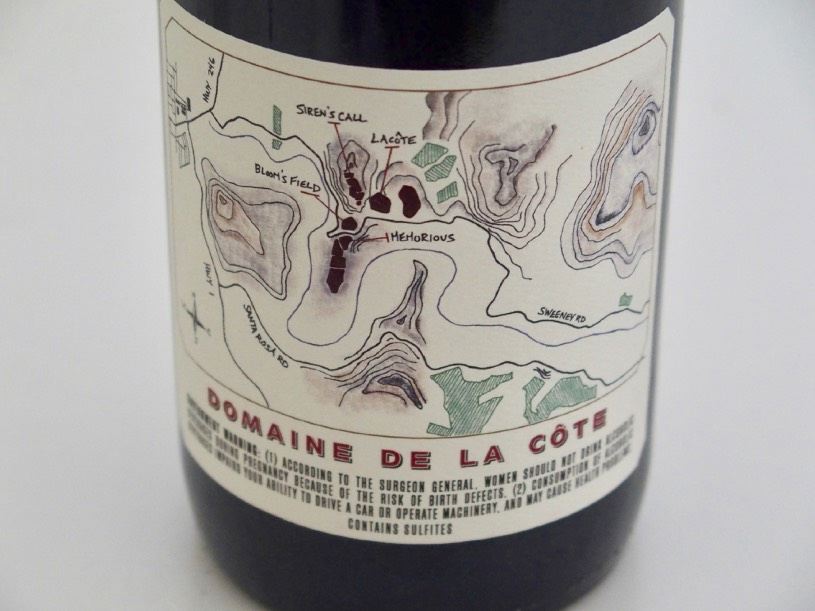 The 2015 vintage marks the fifth vintage from the Domaine and is the smallest vintage ever bottled. A fourth bottling from Siren’s Call Vineyard is not reviewed here. Environmental stress was high at this site leaving very little of this wine. Siren’s Call is only available as a dedicated case with a limit of 1 case per person. All wines are estate grown, produced and bottled by Domaine de la Côte, Lompoc, CA. Memorious Vineyard reportedly developed a new dimension in the 2015 vintage. Natural concentration forced by low yields produced a Memorious with greater depth of expression and complexity than was evident in previous vintages. This was clearly evident to me even though I was unaware of the owners’ realization until after I had sampled the Domaine’s wines. The 2017 harvest marks ten years since Memorious was planted and ten years since the owners embarked on the generation-long project of planting Pinot Noir from seed. This is a very rare undertaking in the world of viticulture, because planting Vitis vinifera from seed is fraught with challenges and impossible where phylloxera is present. Recently, the story of the planting of seedlings at Domaine de la Côte was related to followers of the winery. To plant from seed, the vine from which you collect seeds cannot be hybridized, the seedlings must be planted where phylloxera does not exist, and the seedlings must produce perfect flowers so they may successfully selfpollinate. The high pH soils, cool temperatures and dry conditions at Domaine de la Côte are inhospitable to phylloxera. The seedlings were sourced from an isolated vineyard in the Sonoma Coast, the Carl Meyer Vineyard at the end of Taylor Lane near Occidental. Planted to Dijon clones and Swan selections of Pinot Noir, this solitary vineyard offered fruit with a low likelihood of hybridization from cross-pollination. In the de-stemming and sorting process, thousands of seeds were harvested from the Carl Meyer grapes. Sashi saved seeds in buckets by his feet. The seeds were then thoroughly cleaned with water. The seeds went into cold storage (refrigerators) encased in dirt. In 2007, when the vineyards of Domaine de la Côte were planted, 1 acre of seedlings was sown along Memorious’ windward edge. It is from these seedlings that Memories takes its name. Of the 7,000 seedlings planted, 5,000 survived. Of the 5,000 living ones, roughly 500 produced and are producing grapes. Those 500 vines produced perfect flowers, capable of self-pollination. Among the 500 are red grapes, pinkish (gray) grapes and white grapes. Likely Pinot Noir, Gris and Blanc. Marking of the vines producing red fruit came next and removal of pink or white grapes from the selection pool. Over the subsequent three vintages, the plan is to tag a narrowing selection of vines whose fruit offers a consistent expression of Pinot Noir. By 2020 the owners hope to isolate a small number of vines from which to fulfill the ultimate promise of the seedlings. From the precious few vines, cuttings will be taken for new plantings. From 2020 forward, additional cuttings will be taken from the selection of vines, replanting the cuttings and building up a new vineyard at the Domaine. If success is achieved in finding vines whose fruit consistently expresses Pinot Noir, then there will be a refresh of the genetic material of 2,000-year-old Pinot Noir. Refreshing the genetic material of Pinot Noir portends a healthier, less vulnerable variety, capable of thriving another 2,000 years. There is also an incredible long shot that by planting from seed and propagating a vineyard on its own roots, phylloxera-resistant Vitis vinifera may be found. The owners remark, “This would be the viticultural equivalent of winning the PowerBall.”
2015 Domaine De La Côte Bloom’s Field Sta. Rita Hills Pinot Noir 13.0% alc., 508 cases, $70. 100% whole cluster. Aged in French oak barrels, 45% new. · Moderate garnet color in the glass. Embraceable aromas of cherry, pine sap, exotic spices, rose petal and burnt tobacco. Mid weight flavors of cherry and boysenberry accent with a pleasing smoky tobacco (not oak tobacco) note. Forward drinking, with integrated tannins and very lively acidity. Whole cluster character is dominant in this wine. The very long finish is both fruity and refreshing. Score: 92
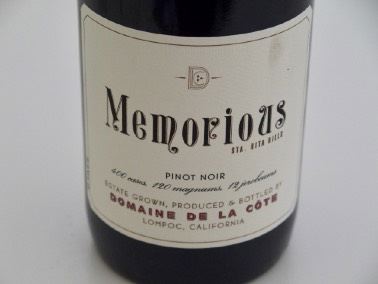 2015 Domaine De La Côte Memorious Sta. Rita Hills Pinot Noir 13.5% alc., 376 cases, $60. 50% whole cluster. Aged in French oak barrels, 25% new. · Moderately light garnet color in the glass. The nose is alive with the scent of black cherry reduction, spice and timber. Intense attack of fresh cherry fruit flavor lifted by bright acidity, and backed by silky tannins. The exquisitely balanced wine just keeps opening and opening, finishing with a extremely long and gregarious finish that is cherry-fueled. Whole cluster character is more moderate and for me, just perfect. Score: 95
2015 Domaine De La Côte la Côte Sta. Rita Hills Pinot Noir 13.0% alc., 370 cases, $90. 100% whole cluster. Aged in French oak barrels, 45% new. · Moderate garnet color in the glass. The whole cluster inspired nose offers aromas of cherry, burnt tobacco and smoked paprika. Brimming with red fruits, this middleweight styled wine has refined tannins, vital acidity, an extra bit of sophistication, complexity donated by whole cluster inclusion, and a perky finish that inspires another sip. Score: 94
FEL Wines, Yountville, CATalented winemaker Ryan Hodgins produces estate wines that strike an impressive balance between power and elegance. Savoy Vineyard is located in the “deep end” of the Anderson Valley where it enjoys a wide diurnal temperature range, with warm summer days and cool nights. Originally planted in 1991 by Richard Savoy, this vineyard was acquired by Cliff Ledge, owner of Lede Family Wines, in 2011. The 44 acres are planted to a diverse blend of Dijon and heritage clones of Pinot Noir (38 acres) and Chardonnay (6 acres). Hodgins oversees Savoy’s farming and viticulture, and manages the vineyard relationships with other producers who craft vineyard-designate bottling from Savoy Vineyard including Littorai, Peay, Radio-Coteau, Auteur and Failla. 2018 marks the 35th anniversary of the Anderson Valley AVA and the 12th anniversary of Hodgins making wine from Savory Vineyard. Visit www.felwines.com.
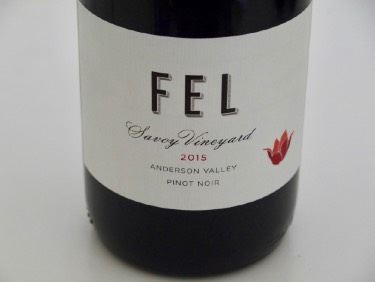 2015 FEL Savoy Vineyard Anderson Valley Pinot Noir 14.4% alc., 805 cases, $70. · Dark garnet color in the glass. The nose leads with aromas of black grape, cassis, pomegranate, earth and bramble. Full-bodied, with a sappy core of luscious dark fruits, attacking the palate with explosiveness. A bold wine, yet harmonious, with matched tannins and supportive acidity, and a deft touch of oak. The gregarious fruit obscures nuances, but the wine will captivate fruit lovers. Score: 94
2015 FEL Savoy Vineyard Anderson Valley Chardonnay 14.3% alc., 203 cases, $48. · Light golden yellow color in the glass. Aromas of lemon oil, white flower blossom, and eucalyptus. Sleek and slightly creamy on the palate, with vivid flavors of lemon-lime and grapefruit and subordinate oak. Nicely composed, holding up nicely when sampled the following day from a previously opened and re-corked bottle kept at room temp. Score: 92
J. Lohr Estates, Central Coast, CAJ. Lohr produced its first Estate wines in 1987, the Riverstone Chardonnay and Seven Oaks Cabernet Sauvignon. In the 30 years since, J. Lohr Estates has become one of California’s most successful brands, offering both quality and value. A majority of the wines are now made from the more than 4,000 acres of estate fruit as well as long-term partnerships with top growers in the Arroyo Seco Monterey, Monterey County or Paso Robles appellations. J. Lohr recently introduced a modern look for its labels; the first label change in over 25 years. Visit J.Lohr.com.
2016 J. Lohr Estates Falcon’s Perch Monterey County Pinot Noir 13.4% alc., pH 3.80, TA 0.60, RS 0.08 g/100ml, $17. This wine is produced from grapes grown in cool climates in Arroyo Seco and Santa Lucia Highlands regions of Monterey County. Dijon clones for the backbone. Harvest Brix 26º average. 3-day cold soak, fermented in open-top tanks and 24-ton upright tanks, light pumpers and daily punchdowns, aged in stainless steel (2/3) and French oak barrels (1/3). · Moderately light garnet color in the glass. Inviting aromas of strawberry, cherry, baking spices and pine. The flavors echo the aromas in a fresh and forward drinking mid weight styled wine that is both juicy and satiny in mouthfeel, with soft tannins and vital acidity. Oak plays a noticeable role in the flavor profile. The wine finishes with satisfying red cherry aromatics. An outstanding value. Score: 89
2016 J. Lohr Estates Riverstone Arroyo Seco Monterey Chardonnay 13.76% alc., pH 3.51, TA 0.70, RS 0.43 g/100ml, $14. Grapes are grown primarily on sandy loam soils underlain with “riverstones,” deposited over thousands of years by the Arroyo Sect River. Harvest Brix 23º. Barrel fermented and aged 7 to 9 months in new to fourth-fill American, Hungarian and French oak barrels that were stirred every 2 weeks. · Light golden yellow color in the glass. The nose is steely, with added aromas of lemon, white flower blossom, vanilla and toasty oak. Slightly creamy in texture, with good brightness, featuring lemon, cooked apple, nectarine, and tropical fruit flavors. A note of burnt toast shows up on the finish. A good value. Score: 88
Spindrift Cellars/Compton Family Wines, Philomath, ORA family owned winery established in 2003 in the southern Willamette Valley. Matt Compton moved to Oregon from New Jersey in 1995. In his younger days, he had long blond hair and most days it was in a ponytail. Matt is a trend setter who steps outside the box, works hard, and puts his heart into making Pinot Noir. He has 20 years of experience and expertise in the husbandry of vineyards. Matt met his now wife Tabitha on a blind date in 1996. The Compton family has now grown with three boys that enjoy working vineyards with Matt and helping, but more often, playing in the winery. The two labels are produced under the Small World Wine Company, LLC. Compton Family Wines is the high end wines that focus on the growing regions of the vines, while Spindrift reflects more general growing regions and is value priced. Visit www.spindriftcellars.com or www.comptonwine.com.
2015 Spindrift Cellars Willamette Valley Oregon Pinot Noir 14.0% alc., pH 3.56, TA 0.57, 1,467 cases, $22, screwcap. Seven small vineyards contributed to this blend, many of which are over 15-years-old and all are dry farmed. Soil types are mostly Alluvial and Bellpine series. Clones are Pommard, Wdenswil, 115, 777 and 667. Average 2.25 tons per acre. Fermented in 1.5-ton open-top fermenters with manual punch downs. Aged in French oak barrels. · Moderately light garnet color in the glass. A savory and earthen aroma greets the nose. Light to mid weight flavors of red cherry and berry with a herbal undertone. Somewhat austere and simple, with soft tannins and a finish alive with cherry scent. Score: 87
2016 Spindrift Cellars Willamette Valley Oregon Chardonnay 13.3% alc., pH 3.50, TA 0.57, RS 0.3%, 345 cases, $25, screwcap. Whole cluster pressed, barrel fermented, partial malolactic fermentation, stirred on lees every week in barrel. · Light golden yellow color in the glass. The nose reminds of Viognier with tropical fruit notes along with citrus and white rose petal aromas. Light and easygoing, with a slightly viscous texture, and fresh flavors of lemon and pear. Refreshing, with a sleek finish. Score: 89
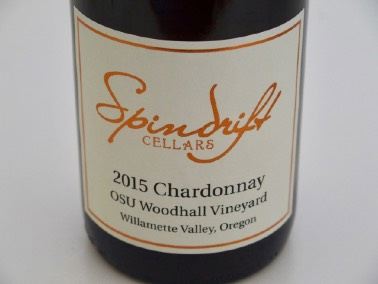 2015 Spindrift Cellars OSU Woodall Vineyard Willamette Valley Oregon Chardonnay 13.5% alc., $25, screw cap. 1978 clone 108. Barrel and fermented and aged 8 months in French oak barrels, 25% new. · Light golden yellow color in the glass. Brims with aromas of lemon, lime, tapioca and underbrush. Modest in weight, but highly flavorful, offering flavors of lemon, pear and a hint of caramel. Clean and beautifully balanced, with a slightly creamy mouthfeel and some finishing persistence. I tried for more deserving descriptors, but this was simply an intriguing and relishable wine. Score: 92
2014 Compton Old Vine Series Llewellyn Cuvée Willamette Valley Oregon Pinot Noir Moderately light garnet color in the glass. Shy aromas of cherry and raspberry align with a scent of earthy flora. Light to mid weight in style featured bright flavors of red cherry and red berry framed by silky tannins. Very lacy and elegant, with a shallow mid palate, a thread of woody oak in the background, and a modest finish. · Moderately light garnet color in the glass. Shy aromas of cherry and raspberry align with a scent of earthy flora. Light to mid weight in style featured bright flavors of red cherry and red berry framed by silky tannins. Very lacy and elegant, with a shallow mid palate, a thread of woody oak in the background, and a modest finish. Score: 88
2015 Compton Old Vine Series Llewellyn Cuvée Willamette Valley Oregon Pinot Noir 13.8% alc., pH 3.54, TA 0.62, 329 cases, $38, screwcap. Mostly Pommard, Wädenswil and Dijon 115 clones from old vines averaging 35 years of age and all dry farmed. Small lot fermentations, aged 18 months in French oak barrels. · Moderately light garnet color in the glass. Very pleasant aromas of chocolate, cherry and spice. The mid weight dark red cherry and blueberry flavors cascade through a welcome attack and mid palate, finishing with length and cherry-fueled goodness. Nicely balanced with added accents of spice, tobacco and saline. Score: 90
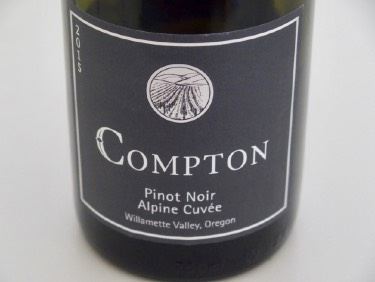 2015 Compton Alpine Cuvée Willamette Valley Oregon Pinot Noir 14.3% alc., pH 3.53, TA 0.59, 444 cases, $38, screwcap. Sourced from multiple vineyards in the “banana belt” of the Willamette Valley where there is a relatively warm microclimate within the hillsides of the Monroe area. Weathered volcanic soils of Basalt and Jory type. Diverse clones. Aged 18 months in French oak barrels. · Moderately light garnet color in the glass. Exceptional aromatic seduction, with aromas of crushed dark berries, underbrush and spice. Like a gift of heaven on the palate, with delicious mid weight flavors of black cherry, black raspberry and warm spices. Outstanding harmony with meticulous oak integration. This beauty really delivers the goods in a darker, riper fruited package with seamless tannin and acid integration. Pinot royalty that was even better when tasted later in the day from an open bottle. Buy this one by the case or two to drink now and over the next few years. WOW! Score: 94
Pinot BriefsCalifornia Wine Strong Support the Napa, Sonoma and Mendocino fires relief at CA Wine Strong: https://www.youcaring.com/mendocinonapasonomacountyfirerelief-977973.
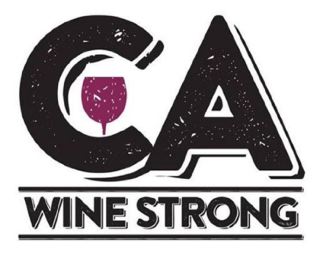 2018 World of Pinot Noir Tickets officially go on sale with early bird pricing Friday, October 20 for the 2018 World of Pinot Noir taking place March 2-3, 2018. The event will include 250 wineries from around the world. The annual celebration of Pinot Noir is held at the Bacara Resort in Santa Barbara, CA. Weekend Pass is $975 (not including lodging). The Friday Grand Tasting is $100 (VIP) or $75. The Saturday Grand Tasting is $137.50 (VIP) or $90. I find the Friday Grand Tasting much less crowded. For more information and tickets, visit www.worldofpinotnoir.com. 2017 Pinot Days Pinot Days San Francisco will be held November 11, 2017, 11:30 a.m.-1:00 p.m. (trade) 2:00-5:00 p.m. (consumer), at Bespoke at Westfield in San Francisco. Consumer tickets are $75. Participating wineries include August West, Banshee, Bernardus, Big Basin Vineyards, Brooks, Bucher, Calstar Cellars, Clos Pepe Estate, Davis Bynum, Donum, Duckhorn, Dutton Goldfield, Expression, Foursight Wines, Furthermore Wines, J Wines, Jigar Wines, J. Lohr Vineyards & Wines, Kanzler, Martinelli, Pali Wine Co. Sojourn Cellars, Square Peg, Stoller Family Estate, Three Sticks, and Trombetta. For tickets, visit www.pinotdays.com. Donald Louis Carano Recently Passed Donald Louis Carano was the founder of Ferrari-Carano Vineyards & Winery, Eldorado Resorts Inc., and McDonald, Carano & Wilson LLC law firm. He passed away on October 3, 2017, at his home in Reno, Nevada, at the age of 85. Carano was a second-generation Italian- American who fell in love with Sonoma County on visits to source California wines for their restaurants in Nevada. After taking classes in winemaking and crafting small lots of his own wines from his home ranch in Alexander Valley, he founded Ferrari-Carano Vineyards & Winery in 1981. Today, this winery owns 24 sustainably-farmed estate ranches comprising over 1,900 vineyard acres in six appellations of Northern California. In 2000, the Caranos acquired the Vintners Inn and John Ash & Co. restaurant. In 2008, they acquired Lazy Creek Vineyards in Anderson Valley. Mr. Carano is survived by his wife Rhonda, five children, 11 grandchildren and six great grandchildren. A video showing the Caranos telling their story: https:// www.youtube.com/watch?v=KPm0xs0fQSA. Santa Cruz Mountains Debuts Wine Trail Signage Any readers who have traveled the back roads of the Santa Cruz Mountains where a GPS is of no value in search of wineries will appreciate this change. The Santa Cruz Mountains Winegrowers (SCMWA) announced recently the approval of a new wine trail signage in the City of Saratoga. These signs are the first phase of a planned Santa Cruz Mountains Regional Wine Trail network to help visitors more easily locate wineries throughout the Santa Cruz Mountains AVA. For information, visit the SCMWA website at www.scmwa.com. 2016 Oregon Vineyard & Winery Census Report Pinot Noir accounts for 64% of all planted Oregon acreage and 57% of production. The northern Willamette Valley leads the state with 73% of total tons crushed in terms of bonded wineries. Total wineries increased from 702 to 725 in 2016 with 554 now in the Willamette Valley. Pinot Noir’s harvested acreage rose to 17,744 in 2016, a 14.4% increase. Case sales increased 10% to nearly 3.4 million helped by a 14% increase in national sales. Harvest 2017 in North Coast The 2017 growing season was a rollercoaster ride with heavy winter rains, record triple-digit Labor Day temperatures (112º in Healdsburg), muggy weather during harvest, and a fiery ending. Most wineries had harvested their fruit before the fires in Sonoma and Mendocino County had begun. The persistent heat led vintners to speed up harvest because of the accelerated ripening. When grapevines are exposed to extreme heat, the stomates in the leaves close to prevent water loss through the leaves, respiration and photosynthesis shut down, and maturation is slowed. If the heat continues, the vine can abort the fruit in an effort to stay alive.Despite the challenging weather, the early expectations from sampling the wines in tank and barrel is reportedly optimistic.
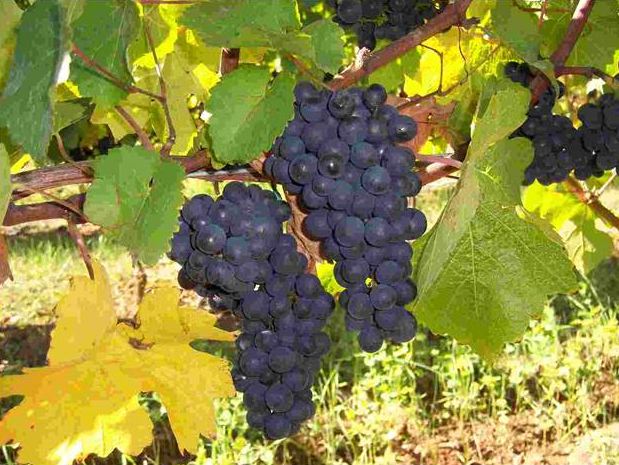 Oregon 2017 Harvest Winter gave up 50 inches of rain during the 6 month dormant period. Summer was marked by high temperatures and very little rain. The first week of August brought record breaking high temperatures with only a slight intermittent drizzle. The extreme heat waves were early in the growing season so the grape quality was not affected. Winegrowers had to remove grape clusters was required to save the quality of the large crop. Milder weather in September and October allowed the grapes to reach full maturity. Jason Lets of The Eyrie Vineyards told The Newberg Graphic, “An absolute classic, superb, healthy, spritely, truly Oregon vintage.” Ernie Pink, winemaker at Amalie Robert Estate in the Willamette Valley, remarked about the solar eclipse that occurred during the later stages of the growing season, “The vines seemed quite oblivious to the whole event.” David Ramey’s Westside Road Winery Approved According to The Press Democrat, September 21, 2017, noted winemaker David Ramey has received approval from the Board of Zoning Adjustments to build a 60,000-case winery, wine cave and tasting room on Westside Road. However, he is expected to receive opposition by local residents who fear added traffic and visitors, and the Board of Supervisors may have the final word. David and his spouse Carla, bought the 75-acre former Westside Farms property five years ago. There are already 29 permitted wineries or tasting rooms in the Westside Road area, long considered the “Rodeo Drive” of Pinot Noir. Two other Westside Road proposals were rejected earlier this year and another small winery and tasting room has been proposed near Ramey’s property. Ramey founded Ramey Wine Cellars in 1996 and grew the winery from 260 cases to 40,000 cases annually.
A Wine Writer’s Dilemmas
 At times I am faced with dilemmas in dealing with wineries. What would you do? • A winery submits wines for review. I review the wines in good faith and publish the reviews online. The winemaker contacts me after the reviews have been published and asks that the reviews be stricken from the website because the wording and/or scores did not meet their expectations. What would you do? I complied by removing the reviews, but would never accept wines for review from the winery again. • A winery submits one or more wines for review. I find one or more of the wines are of poor quality for any number of reasons and would have assigned the wines very low score(s). What would you do? I contact the winery and explain my findings and give them the option to request that the reviews not be published, a request the winery always answers in the affirmative. • A winery submits two bottles of a wine for review. One bottle is flawed due to any number of reasons. The second bottle is fine. What would you do? I usually publish the review of the stellar bottle. Still, I am always concerned that I should be alerting the reader to the possibility that some bottles of this wine may have a flaw. • The writer makes an appointment in advance to meet the winery owner at his winery and taste. When the writer shows up at the appointed time, the owner is not at the winery, and leaves no regrets afterwords. What would you do? I never went back to that winery again. • Wineries continue to ship wine in unseasonably hot weather. Yesterday and today in October, the temperature was 96º-97º F at my delivery point in Southern California, and I nevertheless received incoming wine shipments to my wine locker. Mind you, many deliveries on hot days are not sent overnight or by special FedEx ColdPak shipment, but sent with either no heat protection or a small cold pack in the center of the shipment (a token attempt to protect the wines). What would you do? If I choose to review the wines, I am not assured that the bottles are pristine or affected by heat (unless the cork is pushed up or their is leakage indicating heat stress). I could determine how quickly the wines were sent as well as when they were sent and delivered, and coordinate this with the weather, and review wines not suspected of significant heat exposure, but this is a time-consuming task. I could refuse to review wines delivered to me between July and October unless sent by protected shipping. I really don’t know what to do. |